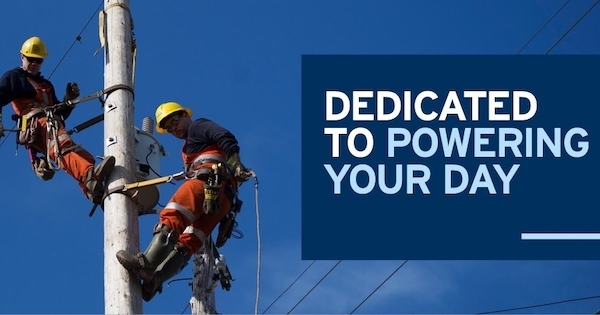The best option would be to make the private utility public again. But don’t bet that will be on the table.
Blame Donnie Cameron. During the early 1990s, Donald William Cameron was an unelected, less than one-term premier of Nova Scotia. In 1991, Cameron replaced disgraced Progressive Conservative Premier John Buchanan, who abruptly quit in the middle of more simultaneous scandals than I can even remember to take a Senate sinecure in Ottawa. In his first general election as leader just over two years later, Cameron led his party to an ignominious defeat at the hands of Liberal John Savage.
Cameron’s political career is remembered for only a few things.
The first, and worst, of course, is the Westray Mine disaster. As the local MLA and minister of development, he had championed the project and lobbied for massive government subsidies to make it happen, despite widespread safety concerns about both the mine and its operator. On May 9, 1992, a methane gas explosion killed 26 Westray miners.
Cameron, who died last year, is also remembered, and mostly for the better, as the dour Pictou County dairy farm boy — “I went to school and went home and did my chores. I never took part in sports or anything,” he told the Canadian Press in 1991 — who grew up to become a parsimonious public crusader against political patronage. He reduced the size of the cabinet, sold off the government’s private plane and forced his ministers to fly economy, not to forget he paid for his own lunches. More substantively, he helped change the appointment process for judges to make it less political and established a non-partisan electoral boundaries commission.
All good. But then, on the night his government was defeated, Cameron huffily resigned both his party leadership and his job as MLA. A month later, he plucked his own plum from the Brian Mulroney patronage tree, accepting a juicy appointment as Canadian consul general in Boston.
Oh, yes, and then there is this for which we also remember him: Donald Cameron was the premier who privatized Nova Scotia Power and created a mess we’re still dealing with today.
A fiscal conservative who campaigned for his party’s leadership on a promise to reduce the province’s debt and deficit, he considered the public utility low-hanging fruit.
In April 1992, 14 months after he was chosen premier by his fellow Tories and 13 months before his government was defeated by his fellow Nova Scotians, Cameron peddled the public utility to private enterprise, despite the fact no one in his government had bothered to do a cost-benefit analysis of the deal.
“It’s just something I believe in,” the Tory-appointed president of the power company told a legislative committee at the time.
An aside. Twenty years before, in 1971, Gerald Regan’s new Liberal government outraged the province’s business community by nationalizing privately owned Nova Scotia Light & Power and folding it in with the much smaller publicly owned Nova Scotia Power Commission. Regan’s goal wasn’t ideological; he saw creating a single utility as part of a larger project to upgrade the province’s power grid. And his government’s decision at the time actually brought Nova Scotia into step with the rest of Canada where 90 per cent of Canadians were served already by public utilities.
Until, of course, Cameron reversed Regan’s nationalization without much concern for the long-term consequences.
One more aside. One of the unintended consequences of Regan’s decision to nationalize the power company was that it turned a Halifax stockbroker named Donald Ripley into an implacable who vowed to “devote my life to kicking Gerry Regan out of office.” Ripley did more than that. More than 20 years later, Ripley went to the RCMP and triggered the investigation that would lead to Regan’s 1998 trial for serial sexual assaults.
But that’s another story.
Back to 1992. Donald Cameron’s government re-privatized Nova Scotia Power, selling off the utility for what was touted at the time to be $192 million but was later calculated as a net loss of $108 million “since the combined equity of NSPC was in the vicinity of $300 million.” Noted the Canadian Centre for Policy Alternatives in a 2012 analysis:
Thus, the initial transaction established an ongoing template: the public interest taken to the cleaners [for the benefit] of private profit. And indeed, since then, NSPI has grown fat at the taxpayer’s expense, generating more than $2 billion in profits for its shareholders.
Things haven’t gotten better since 2012 — except, of course, for those shareholders.
NSPI — now owned by its own bastard spawn, Emera — is a private monopoly with a guaranteed rate of return it is constantly angling to increase. Its executives’ more than generous salaries are frequently topped up with even more generous bonuses, apparently for goosing up shareholder value while skimping on customer service, maintenance and infrastructure renewal.
Late last month, Nova Scotia Power submitted an application to the Nova Scotia Utilities and Review Board for what amounts to a 10 per cent rate increase over three years. Its 3,152-page application contained a cornucopia of buried shareholder treats that are only now beginning to be uncovered.
Allnovascotia.com’s Gillian Cormier, for example, reported that, on page 80 of its application, the utility asks for “two changes to its profit-earning mechanism.
The first is to expand its allowable earnings band from 8.75 per cent to 9.25 per cent, to 8.5 per cent to 9.5 per cent, giving it an additional 0.25 per cent of potential upside.
The second change is a proposal that would allow it to earn above this fixed amount — so long as it splits that amount with its customers…
Previously, that money went back to customers.
And then there is its proposed new “storm recovery charge” to cover any costs incurred to turn the lights back on after storms. As my colleague, Jennifer Henderson noted:
Nova Scotia Power is asking customers to cover every imaginable cost attached to storm preparation, clean up, and restoration separate and above what is currently covered through the monthly power bill.
“All non-capital preparation, response, and restoration related costs associated with Level 3 and Level 4 storms will be eligible for inclusion in the Storm Rider, including (1) storm preparedness including crew staging and related logistical expenses; (2) incremental NSPI wages, benefits, and overtime pay related to storm recovery; (3) costs of external service providers and mutual aid utilities hired by the Company during restoration efforts; (4) materials and supplies used to repair damaged assets and any associated expenses; (5) other recoverable expenses, including extra costs for temporary repairs and to expedite the permanent repair of damaged property and expenses incurred for providing services to customers whose electric service has been interrupted.”
Service interruptions?
Last Thursday (February 3), there was what Nova Scotia Power unhelpfully described as a “transmission interruption” that closed more than a dozen schools and cut off power to more than 24,000 customers from Dartmouth to Eastern Passage and North Preston. That same day, 2,300 customers in the Lake Charles area lost their electricity because of “salt contamination.” And then of course came a real storm they will want us to pay for.
Perhaps, instead of charging us to restore power, the Utility Review Board should reduce NSP’s guaranteed rate of return for every power interruption. That would get shareholders’ attention!
Meanwhile, to undermine potential competition from those who install solar energy for their homes, Nova Scotia Power applied to charge customers for selling their excess power back to the grid, a move experts said would — perhaps not coincidentally — decimate the province’s nascent solar power industry.
That finally brought new Premier Tim Houston, whose party supports solar energy, into the fray. Dawning the cloak of Consumer Protector, he wrote a letter to the province’s Utility and Review Board, telling it not to waste its time considering NSP’s solar power provision. Instead, he said the province “plans to quickly bring into effect the necessary legislative and regulatory framework” to scuttle the utility’s solar power grab in order to “support the greening of the grid, not discourage it.”
In response, Nova Scotia Power withdrew its solar provisions.
As for other aspects of Nova Scotia Power’s application, Houston told reporters, “no option is off the table… It’s time to look at every aspect of the relationship between Nova Scotians and Nova Scotia Power.”
It would be nice if “no option off the table” included the possibility of making Nova Scotia Power a for-the -public public utility again.
Don’t hold your breath.
***
A version of this column originally appeared in the Halifax Examiner.
To read the latest column, please subscribe.








 STEPHEN KIMBER, a Professor of Journalism at the University of King's College in Halifax and co-founder of its MFA in Creative Nonfiction Program, is an award-winning writer, editor and broadcaster. He is the author of two novels and eight non-fiction books. Buy his books
STEPHEN KIMBER, a Professor of Journalism at the University of King's College in Halifax and co-founder of its MFA in Creative Nonfiction Program, is an award-winning writer, editor and broadcaster. He is the author of two novels and eight non-fiction books. Buy his books